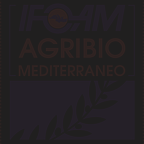Olive Foliar Diseases under Climate Change
by Dr. Yizhar Tugendhaft
Olive scab (Peacock’s eye disease, olive leaf spot, repilo) caused by Fusicladium oleagineum and cercospora olive leaf spot, caused by Pseudocercospora cladosporioides, are both major olive foliar diseases in olive growing regions around the world. Severe infection may result in loss of leaves, young shoots and inflorescences, and damaged fruits. Both fungi are spread when appropriate temperatures and humidity exist in the olive orchard.
Control of those diseases is done in cultural and chemical means. An effective cultural mean is intensive pruning of tree canopy, for good ventilation. Chemical means for disease control are copper compounds for preventive treatments and systemic fungicides for the reduction of disease severity in infected leaves.
the organic farmer can use only copper compounds as a chemical means of control. This is an environmental contaminant so its annual use is restricted. These limitations require increased awareness of weather conditions that favor disease spread and to climate change.
Olive scab:
F. oleagineum mainly penetrate the upper side of the olive leaf, when air relative humidity is above 98% (López-Villalta, 1999). Disease severity is significantly affected by temperature, wetness duration, and their interaction (Viruega, 2011). Germination will occur in temperatures from 3 to 35°C but is subjective to wetness duration. Incubation period, from leaf infection to new sporulation, may last three weeks at 15°C (Benkada, 2015). Viruega et al. (2011) have found that disease severity is low when wetness duration is shorter than 12 hours. Longer periods of wet air increases disease. For wetness periods shorter than 24 h, disease severity was greatest near 20°C. For wetness periods longer than 24 h, disease severity was greatest near 15°C. At 5°C, infections were detected only for wetness periods longer than 18 h.
Cercospora leaf spot:
P. cladosporioides spores are produced at temperatures from 12 to 28°C and mycelium penetrate the leaf through stomata or lesions (López-Villalta, 1999). Incubation period could last from 7 days and up to 11 months (Ávila, 2020). Other Cercospora species were found to spore and germinate at relative humidity higher than 92% (Paul, 2005) or 98% (Kumar, 2011). An intensive use of fungicides may result in resistant strains. The bacterial olive knot disease, caused by Pseudomonas savastanoi, already have several copper resistant strains (Nguyen, 2018).
Climate change
A model published 12 years ago predicted a robust climatic change in the Mediterranean. Higher winter minimum and summer maximum temperatures, decrease in annual precipitation and changes in its distribution (Giorgi, 2008). the last report from the International Panel on Climate Change (IPCC, 2013) highlights the Mediterranean as one of the most vulnerable regions in the world to the impacts of global warming. The models estimate an increase in average surface temperatures in the range of 2.2 and 5.1 °C for the period 2080–2100. For the same period, the models indicate pronounced rainfall regime changes in the Mediterranean, and estimate that precipitation over lands might vary between -4% and -27%. (climate-change-mediterranean, 2020). These changes are already here. Winter temperatures rises, Rain events are shorter, stronger, and later in the season.
Conclusions:
Olive foliar diseases pose a significant threat to oleiculture economy. Yield and oil quality reduction are a sure result of poor disease management. The organic olive grower must be aware of weather conditions and plan fungicide application accordingly. The use of weather forecasting services and in-field monitoring could increase treatment efficacy and value per cost ratio.
Both Olive scab and Cercospora leaf spot propagate at the same climatic conditions, attack the same tissues, and causes similar damage. Since control methodology is similar, both could be addressed as one disease complex.
Intensive pruning of sensitive varieties and proper spray application on both upper and lower sides of leaves are important cultural tools.
Means of biological control (vegetal and microbial) must be developed, to reduce the use of copper compounds in the organic olive orchard.
Original article by Dr. Yizhar Tugendhaft on behalf of IFOAM AgriBioMediterraneo’s Organic Olive Growers’ Forum.
Subscribe to the Organic Olive Growers’ Forum newsletter for more information.
References
Ávila, A. R.-B. (2020). Phenotypic and pathogenic characterization of Pseudocercospora cladosporioides, causal agent of cercospora leaf spot of olives. European Journal of Plant Pathology, 156, 45–65. doi:10.1007/s10658–019–01861–5
Benkada, M. M. (2015). Isolation of monosporal strains of Fusicladium oleagineum, the fungal causal agent of olive leaf spot from North-Western Algerian groves. International Symposium of Applied Biology. 6, pp. 64–68. CIBA: IJSRST.
climate-change-mediterranean. (2020, June). Retrieved from www.iucn.org: https://www.iucn.org/regions/mediterranean/our-work/climate-change-mediterranean
Giorgi, F. P. (2008). Climate change projections for the Mediterranean region. Global and Planetary Change, 63(2–3), 90–104. doi:10.1016/j.gloplacha.2007.09.005
Kumar, R. P. (2011). Effect of relative humidity, temperature and fungicide on germination of conidia of Cercospora canescens caused the Cercospora leaf spot disease in mungbean. Archives of Phytopathology and Plant Protection, 44(, 44(16), 1635–1645.
López-Villalta, M. C. (1999). Olive pest and disease management . Madrid: International Olive Oil Council.
Nguyen, K. A. (2018). Efficacy of copper and new bactericides for managing olive knot in California.. Plant disease, 102(5), 892–898.
Paul, P. A. (2005). Influence of temperature and relative humidity on sporulation of Cercospora zeae-maydis and expansion of gray leaf spot lesions on maize leaves. Plant Disease, 89(6), 624–630.
Viruega, J. R.-C. (2011). Factors Affecting Infection and Disease Development on Olive Leaves Inoculated with Fusicladium oleagineum. The Plant Genome, 95, 1139–1146. doi:10.1094/PDIS-02–11–0126.
